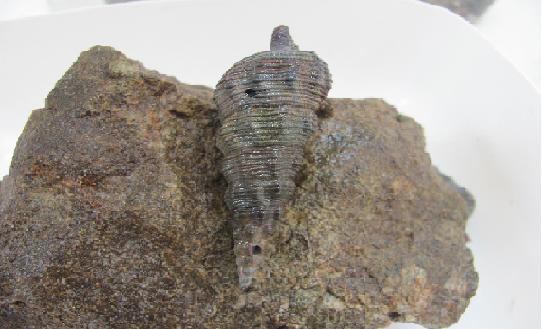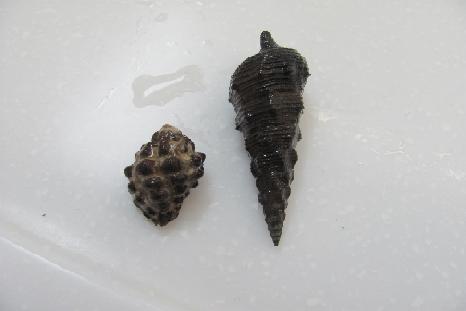Life History & Behaviour
INTRODUCTION
The predatory snail species Morula marginalba, also known as the Mulberry Whelk, is an abundant snail in the intertidal and rocky shores of eastern Australia. This study will look at two behavioral process of the snail: the predation on other snails and the ability to right itself. The diet of M.marginalba consists of oysters, limpets, and barnacles. (Fairweather et al. 1984) One of the aims in this study is to see if the Mulberry Whelk will predate on other gastropods, particularly the larger species Pyrazus ebeninus, common name Hercules Club Mud Whelk. This study also will look at the snails’ ability to right themselves, or turn themselves right side up when placed on their dorsal side. The snails will be placed on different substrates to see how long it takes them to right themselves and if the substrates make a difference. The three substrates used are a bare control substrate, fine sand, and rock. It is hypothesized that the snails will have a faster righting time on the rock substrate than the sand substrate and that the Morula marginalba will predate on the Pyrazus ebeninus.
METHODS
The study was done at one of the laboratories at the University of Queensland. The species M. marginalba were collected on the rocky shore at North Stradbroke Island and transported to aquariums at UQ. Six days passed before the animals were tested. A total of 26 individuals were measured for length. The dorsal side was measured from tip to tip. These 26 snails were then tested to see how much time it took them to right themselves on different types of substrate. The first substrate was the control which was a bare container that only contained seawater (Figure 5). All 26 animals were placed on their ventral side at which time the stopwatch started. The stopwatch was stopped when the animal had fully righted its shell and the times were recorded. The animals were put back in the aquarium. The next week the animals were tested on the second type of substrate, which was fine sand (Figure 6). The same process was repeated except only15 animals were tested. The animals were placed back in the UQ aquarium and 7 snails of the species Pyrazus ebeninus were put in the same tank. The tank was cleared of any other animals and so only the two species of snails were in the tank. Another week passed and the 7 P. ebeninus individuals were examined. Holes in the shell were observed and the number and location of the holes were recorded. The 26 M.marginalba individuals were then each placed on rock for the third and final substrate type (Figure 7). The timing and recording process was also repeated. Each time the animas were tested they were completely emerged in seawater and had no other individuals on the same substrate. Also for each test the snails were giving a max of 15 minutes to right themselves. A t-test was used to determine if there was a significant difference between the data.
RESULTS
The average length for the snails was 24mm. The largest snail was 30mm. When the snails were tested on the bare substrate the average time was 4’4” (Figure 8). The fastest time was 41 seconds. There were 3 snails that maxed out at the 15 minute mark. One small snail that maxed out at 15 minutes tried 6 times to attach to the substrate to right itself. There was also one snail that was oddly shaped and also maxed out at 15 minutes. On the sand substrate the snails had an average righting time of 14’1” (Figure 8). Only 15 snails were tested and 13 of those snails maxed out at 15 minutes. Only two snails righted themselves in less than 15 minutes and their times were 8’44” and 8’59”. When tested on the rock, the snails had an average time of 1’6” (Figure 8). All 26 snails righted themselves in less than 6 minutes. The longest time was 5’45” and the fastest time 23 seconds. The t-test yielded a significant p value of 1.93e-22. Out of the 7 P. ebeninus individuals, 3 of them were still alive. Only one snail didn’t have any holes in the shell and one snail yielded the most holes, which was three (Table 1). An example of the holes seen on the shells can be seen in Figure 9.

Figure 5. The control substrate which was a bare container.

Figure 6. The second substrate which was the fine sand.

Figure 7. The final substrate which was the rock.

Figure 8. The average time, in minutes, for each of the three substrates.
Table 1. The snails were arranged by size, A being the smllest and G the largest. The number and location of the holes can be seen for each snail.


Figure 9. Two holes found on snail A.

Figure 10. The size differnce between the two whelks.
DISCUSSION
There was a significant difference between the sand and rock substrate. The hypothesis was correct in that the snails had a much faster time on the rock than the control or sand substrate. One of the factors that affected the time was the size of the snails. On the control substrate the snail that tried 6 times and couldn’t attach itself seemed to be too small. His body couldn’t stretch far enough to attach to the substrate. The oddly shaped one also had a hard time stretching far enough to reach the substrate. He was more round than the others and so sat farther up from the substrate. He tried 4 times but eventually maxed out at 15 minutes. The sand was hard for the snails to attach to. When they did reach the substrate the sand wasn’t firm enough for them to be able to attach and right themselves, which would account for the reason why all snails but two maxed out on time.
The hypothesis was also correct in regards to the Mulberry Whelk’s predation. The snails did predate on the other species. The P.ebeninus species was much larger than the M.marginalba but they outnumbered them 26 to 7. Majority of the holes drilled from the radulas of the Mulberry Whelks were located on the tail end of the Hercules Club Mud Whelks. This could be because the tail end was the easiest part of the prey to get to for the smaller Mulberry Whelk.
One limitation of this study is that there were people walking by in the lab and also sometimes someone would accidentally hit the table and scare the snails. The snails would be about to attach to the substrate when they would get scared and snap back into their shell. For future study, trying to minimize people around the area would help. Also, when trying to determine the predation of the snails, being able to have a video camera set up to record the snails feeding on the other species of snail would also help with evidence.
The rock substrate proved to have the quickest righting time. The M. marginalba are found on rocky shores and so the rock is their natural habitat and easiest for them to right themselves on. Other gastropods aren’t normally on the prey list for the Mulberry Whelk but when all other food sources are absent then they will do what’s necessary and predate on other larger snails.
|